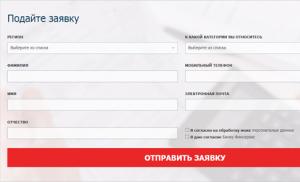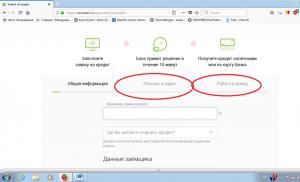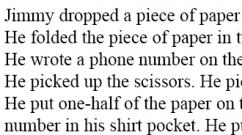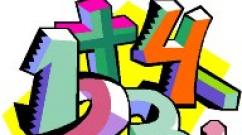Numbers in German up to 100. German counting as an important detail when learning a foreign language
If you have ever been abroad, in a country whose language you know only a little, then you probably know that feeling when you stand at the checkout in a supermarket and frantically look for a number on the monitor screen ... because you don’t understand numbers by ear ... because that has not yet learned them.
Not only my German students, but also the Germans who study Russian with me complain about the numbers. Why teach them? Why waste time on them? It seems that the numbers are a barrier that requires a serious time investment. Is it so?
In fact, the numbers are important. Even if in the modern world they can be quickly shown on the phone. Or peep on the cash register monitor in the store. What are the numbers for?
- Numbers refer to the basic vocabulary of any language
- Numbers are important not only for understanding prices, but for formulating the year (1569, 1897, 2010)
- For the wording of the date
- For the formulation of time
- To formulate ordinal words (second, fifth, tenth, twenty-first)
- To formulate the quantity (two tomatoes, three hundred grams of flour)
- and many more
If in a supermarket you can look at the checkout screen, then in small shops or bakeries, monitors are not always visible. At the post office, too, the price is often called by ear. But when it comes to prices, there is often a price tag on the product. Therefore, with prices, everything is not so difficult.
And how to say without knowing the numbers, how old are you? How far did you come to Germany? How many months or years do you study German? How much money do you have with you? When's your birthday? And how many kilograms does your luggage weigh?
Numbers are important, so you can't just skip them. It is not necessary to learn how to write numbers, especially long ones. But writing numbers from 1 to 10 is mandatory. Yes, teaching them can be boring and monotonous. But there are some unusual ways to practice numbers instead of monotonous rote learning.
Method 1
Repeat numbers as often as possible. Climbing the stairs to the second floor, you can count the steps in German. First, you can start counting from one. Another time you can start with thirty. One time the numbers in order, the other time - through the number.
Those who do not climb stairs can use the TV. For example, you can switch channels and count them. Or count how many keys are on the keyboard. How many cars are in the yard. How many pairs of shoes are in the hallway. Say your phone number. The possibilities are endless.
Method 2
Practice naming dates. For example, to name in German the year of birth of relatives and friends. Recall significant dates from world history and practice naming them. Then practice naming the days of the month. At the beginning of the year and the day of the month, it is worth training separately, because ordinal numbers are used for days. For example, you can practice naming the dates of the holidays. And also, how long are the New Year holidays, summer holidays and so on. Then you can move on to training complete dates with the name of the day of the month and the year.
Method 3
Do math. Take, for example, the number 7. Seven is 5+2. And eight is 3+5. In this way, you can practice adding, subtracting, multiplying and dividing numbers in German.
7 = 5+2
8 = 10-2
6 = 3x2
9 = 18:2
It is important to pronounce the numbers not to yourself, but out loud. Not only the brain, but also the lips must remember what to say. This exercise can be done in pairs or groups, when one person thinks of a number and explains it, while others guess. For example, how much is 3+5+7-2?
Another option for group work is to play the lottery or bingo. You can also play sea battle. In this case, you can write numbers from 1 to 10 vertically, and horizontally from 11 to 20. Thus, each player names two numbers at once. You can also exchange phone numbers, home address (numbers are especially important, because they are in the address!) and conduct a numerical dictation.
Do you know other ways to remember numbers? Share in the comments.
11/18/2014 TUESDAY 23:50
GERMAN LANGUAGE FOR BEGINNERS. LEVEL A1
Align="center">
Wortschatz zum Thema (words to the topic):
die Telefonnummer - phone number
die Zahl - figure, number
die Zahlwörter - numerals
brauchen - need
das ticket - ticket
das Buch - book
Numerals
Numerals in German: 
from 1 to 12 - everything is clear
from 13 to 19 we read and write 13 dreizehn as (3.10), 14 vierzehn (4.10), etc.
21 to 99 are written and read backwards - 21 einundzwanzig (1 and 20), 33 dreiunddreißig (3 and 30)
Numbers after 101 are written together. Don't worry, they should be this long:
500 - funfhunderd
4000 - viertausend
441 - vierhunderteinundvierzig
50,000 funfzigtausend
700 000 - siebenhunderttausend
1 000 000 - eine Million
9 300 400 - neun Millionen dreihunderttausendvierhundert
If you need to name a four-digit number, then first the number of thousands is called, then the number of hundreds, and then the two-digit number - tens and ones.
For example: 2581 = zweitausendfünfhunderteinundachtzig
If we break the word into generators, we get:
zweitausend + fünfhundert + ein + und + achtzig
(two thousand) (five hundred) (one) (and) (eighty)
How old are you?
.jpg)
Wie alt bist du? - How old are you?
Wie alt sind Sie? - How old are you?
Ich bin … Jahre alt - I am … years old
Ich bin ... - To me ...
For example:
Ich bin sechsundzwanzig (26) Jahre alt (literally: "I am 26 years old") - I am 26 years old.
Er ist vierzig(40) Jahre alt - he is 40 years old.
Du bist zwanzig(20) Jahre alt - you are 20 years old.
How?
Wie viel? - How many? (for uncountable)
Wie viele? - How many? (for countable)
For example:
Wie viele Tickets brauchen Sie? - How many tickets do you need?
Wie viel kostet dieses Buch? - How mach is this book?
Exercises:
1. Write down the phone number in numbers:

2. Write the corresponding figure:

3.Write in words:

Keys to lesson A1-2:
1. Arrange the lines in the dialogue:

2. Fill in the blanks:
Grossbritannien Spanien Grossbritannien Frankreich Italien.
German counting is important in the early stages of learning a language. As a rule, the first words upon arrival in a country where German is spoken are associated with shopping in a store. And when it comes to money, you need to know the score. In German, it is also important to know the numerals if you want to remember the rules of reading. This would be a great mnemonic device.
Counting in German up to 10
To begin with, you just need to say about how the numbers in German up to ten are read and written.
One is pronounced "ains" and is spelled like this: eins. Do not confuse this word with the German language - ein. So, the phrase "one house" would be read as "ein Haus". And if we are already talking about the number of the building, then the German account will be used: "Haus Nummer eins" - translated as "house number 1".
Two - zwei, read: "zwei".
Three - drei, pronounced as follows: "dry".
Four - vier, in Russian it sounds like "fir" with a long "and" sound.
Further, respectively: fünf ("funf"), sechs ("zeks", the letter s at the beginning of the word is read as voiced), sieben ("zibn", also with a long "and"), acht ("aht"), neun ( "noin") and zehn ("zein"). You can also add 11 and 12 to these numbers, since they are not read according to the rules: "elf" and "zwelf" respectively. Elf - 11, zwölf - 12.
Counting in German from 1 to 12 is taught in the earliest stages of language learning, both by adults and children, almost immediately after the alphabet. Next comes the complication: tens, hundreds, etc.
How to pronounce numbers for prices
When buying goods, it will be important to know that the Germans do not say the word "euro", "dollar", "cent", etc. So, if the cost of the goods is, for example, 3.5 euro, then it will sound like "three fifty ": drei funzig. Accordingly, more complex prices will also be read without currency names: 25.25 euro - "twenty-five twenty-five": fünfun dzwanzig fünfun dzwanzig.
German counting for memorizing reading rules
In German, as a rule, words are read as they are written. However, there are exceptions and difficulties, such as diphthongs, which can sometimes be difficult to remember. To memorize the rules of reading, German numerals are just very well suited. This mnemonic technique will help to consolidate the studied material and will be a kind of cheat sheet.
So, for example, in the first numerals of the German account, we see the diphthong "ei", which is read as "ai": eins, zwei, drei.

Further, in the number 4 - vier, a completely different diphthong - ie. It is read with a long sound "and" (fiir). The same sound is seen in the number "seven" - sieben. Many language learners confuse these diphthongs because they are very similar. However, if you learn by heart the spelling of numerals in the language of Goethe and Schiller, then this will be an excellent cheat sheet for all time.
The German account will also help with memorizing other diphthongs. So, the diphthong "eu", read as "oh", is seen in the number "neun" - nine.
And the rules for reading the letter h after vowels can be understood if you know the rules for reading the number 10 - zehn, "zein".
Here are the rules for reading other special letters. So, for example, z is read as "ts", and this follows from the pronunciation of the numbers "two" - "zwei", "twelve" - "zwelf".
A vivid example of the rule for reading the letter s at the beginning of a word is the numbers "six" and "seven": "zeks", "zibn".
Learning to ask and tell the time
In German, to find out what time it is, you need to ask: "Wie spat ist es?", which literally translates "How late?", or "Wie viel Uhr ist es?". So:
Wie spat ist es? What time is it now?
Es ist zwölf Uhr. Twelve o'clock.
East ist halb acht. Half past seven.
Es ist zwölf Uhr dreissig. Twelve thirty.
Es ist funfzehn Uhr vierzig. Fifteen forty.
Es ist punkt zwei. Roughly two.
As you can see from the examples, first the hour is called, then the minutes, and the word "Minuten" not used. This happens when denoting any quantities (hours, kilometers, euros, etc.): a larger value is called, and a smaller one is indicated only by a numeral: fünf Uhr zehn; sieben Eurofünfzig.
In German, as in Russian, one can also say "two hours", And "fourteen hours": "Es ist zwei Uhr", "Es ist vierzehn Uhr". The only difference is that the second option is more formal. In colloquial speech, the beginning of a sentence can also be omitted "es ist":
Wie spat ist es?— Neun Uhr.
As in Russian, German uses such notations as "half", "quarter", "no quarter/ten" etc. Half and a quarter are very easy to remember: these are words "halb" And Viertel. FROM "halb" no prepositions required:
Es ist halb neun.- Half past eight.
For everything else, you need to remember two prepositions "nach"(after) and "vor"(before):
Es ist Viertel vor sechs.- Fifteen minutes to seven. (5.45 - fifteen minutes to six)
Es ist Viertel nach sieben.- Fifteen minutes after seven. (7.15 - fifteen minutes past seven)
Es ist zehn Minuten nach acht.- Five past eight. (8.05 - five minutes after eight)
Es ist zwanzig Minuten vor drei.— Twenty three minutes. (14.40 - twenty minutes to three)
Don't get confused words "Uhr" And "Stunde". Both of these words are translated as "hour", but "Uhr" only used when you are naming a time: "Es ist sechs Uhr"- Four o'clock. "Stunde" used when you need to specify the duration of some action: "Ich schlaffe sechs Stunden"— I sleep 6 hours.
to say "at midnight" And "at noon", remember the following expressions:
am Mittag- at noon
um Mitternacht- at midnight
Another issue related to time is not "What time is it now?", but "When?". This question is relevant when scheduling meetings, and to answer it, you need a pretext "um":
Wann ist der Film? Um 7 Uhr. (What time is the movie? - At 7 o'clock.)
Wann commst du?— Umeins. (When will you come? - At one o'clock)













